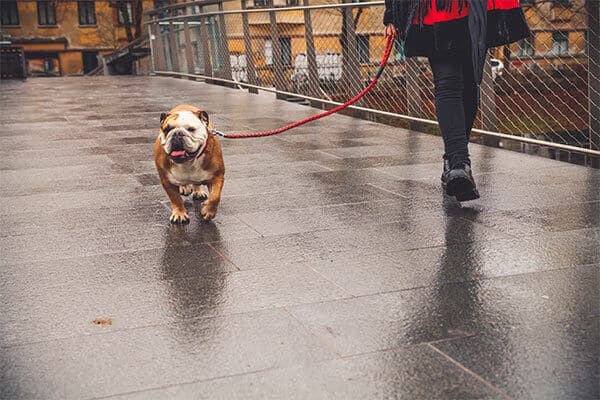Walking a dog has many advantages for both you and your dog. You both get exercise and fresh air, and you get a chance to bond. But how long should you walk your dog? In this article, I will give several examples of how long to walk for each dog, as well as list the benefits of walking. So, how long to walk a dog?
A dog should be walked for at least 30 minutes a day and up to about two hours a day. You can walk them once a day, but 2 or more walks are ideal. More relaxed dogs, as well as very young or very old dogs, won’t need as long. Energetic dogs will need to walk for longer.
Walking your dog is more than just going to the bathroom for them, and is more than walking around the block. Walks help with their physical, mental, and emotional well-being. Read on to learn more about how long to walk a dog and its benefits.
How Long to Walk a Dog?
How many walks and how long to walk your dog depends on you and your dog. You may find that your dog likes one long walk in the morning and then just lie around sleeping in the afternoon. Or, they might like to lie around all day and then get a walk in the later afternoon. Also, depending on your schedule, if you’re busier in the day or the night, your free time will dictate when and for how long you’ll be walking your dog.
Generally speaking, dogs like huskies and hounds may prefer other activities when you don’t go out for a walk, like playing fetch in your yard. Terriers, on the other hand, are known to get bored quite easily, and they will need more walks than others.
Puppies and elderly dogs should go for shorter but frequent walks that give them plenty of time to rest so that they don’t create any stress on their bones and joints.
Here is a useful guide to figuring out how often and how long to walk a dog, depending on its breed:
| Dog Breed | How Often to Walk | How Long to Walk |
| Herding dogs like shepherds, collies, corgis | 2 – 3 times a day | At least 2 hours and extra indoor activities for large breeds. |
| Sporting dogs like retrievers, spaniels, and pointers. | 2 – 3 times a day | At least an hour and a half, plus extra indoor activities for large breeds. |
| Hounds – greyhounds, Afghans, Dachshunds | Once a day | About an hour and a half for larger breeds, up to an hour for smaller breeds. |
| Small terrier breeds like Scottish, Manchester, and Lakeland | Twice a day or more | Around an hour for most breeds and up to 2 hours for larger breeds. |
| Large terrier breeds like boxers, Dobermans, and Rottweiler | One long walk in a day | An hour and a half or as long as 2 hours for most breeds. Even up to 2 and a half hours for large high-energy breeds. |
| Toy breeds like Maltese, poodle, and Lhasa Apso | Twice a day. Think shorter but more frequent strolls. | Half an hour to an hour for most breeds. |
Below are more details on how long to walk specific popular dog breeds:
Smaller Dogs
Smaller dogs like the Dachshund, Corgi, Chihuahua, Miniature Schnauzer, Cocker Spaniel, Beagle, etc., should walk for at least 30 minutes a day, up to about an hour a day. They have shorter legs making them unable to walk as far or as fast as bigger dogs. However, their stamina varies from dog to dog. More relaxed dogs will only need about 30 to 45 minutes of daily walking. Energetic dogs, even the smallest ones, can walk for 1 hour+ each day.
It is best to break the walk into two walks a day if possible. If your dog has good control and responds well to your commands, it is best to walk them off-leash.
Bigger Dogs
Some of the most popular bigger-sized include the German Shepherd, Labrador, and Golden Retriever. These dogs vary in size but generally are about 25 to 32 inches (67-82 cm) tall in their adult age, making them more capable of greater speed and distances.
German Shepherds are one of the best working dogs. They are known for their police work, able to go long distances to track criminals. The Labrador Retriever is a highly popular breed of dog breed in the US, Canada, and the UK. It is used for disability assistance, e.g., walking long distances in a calm manner with blind owners. As the name suggests, the Labrador Retriever is great at retrieving or playing fetch.
The more relaxed German Shepherds, Labradors, and Golden Retrievers should get at least a minimum of 45 minutes of playful, brisk walking, jogging, or running. Generally, these dogs should be walked for about 1 hour a day. The most energetic of them could use 1.5 to 2 hours a day.
How Far to Walk a Dog
Since we’ve previously covered how long to walk a dog, depending on the breed of the dog, it’s time to figure out how far to walk your dog. The distance you and your pet can cover depends on both of you – the pace you’re going and, of course, how fit and physically able your pet is.
If you are out on a stroll with a senior dog or a small dog, you probably won’t go that far before your dog shows signs that they’re already tired. Larger dogs can cover a lot of ground with you while you walk briskly. The path you’re walking on – incline, terrain, and the weather – will also determine how far to walk a dog.
A walk of around one to three miles is enough to make your dog happy. However, larger and more active dogs may want to walk even further. Keep in mind that if you’re walking a puppy, just a mile is enough. You should let the puppy set the pace for your walk, how fast or how slow you should go. The time spent outside will help stimulate their senses and keep them happy.
The Benefits of Walking Your Dog

Walking your dog is not all about going to the bathroom – it helps keep your dog healthy and happy. Below are some of the benefits that your dog will gain from walking regularly with you.
Physical Benefits
- Improved cardiovascular fitness
- Lower blood pressure
- Stronger bones and muscles
- Prevent degenerative joint diseases
- Help keep weight in a healthy range
Mental and Emotional Benefits
- Establishes and strengthens the bond you have with your dog
- Helps keep boredom away
- Allows them to explore the outdoors
- Lets them play and socialize with other neighborhood dogs
- Stimulates your dog’s brain due to the different sights and smells
Walking your dog benefits not only your dog but you as well! Pet owners can enjoy the following benefits.
Benefits for Dog Owners
- Walking is a great form of exercise, and by walking your dog you hit two birds with one stone – you get to exercise and bond with your pet at the same time.
- People with pets are often regarded by others as someone who is friendly and approachable. Your pet is often a great icebreaker and conversation starter!
- Walking and stroking your pet helps reduce stress and anxiety.
- Since pets give unconditional love, this is said to have mental health benefits for pet owners, particularly increased self-esteem.
- Walking your dog out on the neighborhood gives you the chance to meet and greet other people.
Some dogs, especially high-energy ones, may need more walks than others. Next, I’ll address some of the safety tips you should follow when walking your dog.
Safety Tips for Walking Your Dog

Walking your dog is not all roses and daisies. There are some things you need to check and consider for you and your pet dog before you go out for a walk.
Have Your Dog Checked by the Vet to Make Sure Everything Is OK
Your dog can’t talk and obviously can’t tell you that they’re not feeling well. Sometimes a walk may not be beneficial at all, and you could be causing your beloved pet harm. It is especially important to get a vet’s advice if your dog has arthritis or if you have a very young or very old dog. Have your vet check your dog before starting any new physical activity to make sure that they are physically capable of doing it.
Make Sure Your Dog Knows Basic Obedience Skills
It’s normal for your dog to become excited about all the sights, sounds, and smells that he or she will meet while out on the walk. This is where knowing basic obedience skills come into play. Your dog should listen and obey your commands instead of rushing up to sniff every dog or person that they meet. Remember, not all people you meet may want to get licked by your dog, so always be in control.
Use the Right Leash and Have the Right Equipment Ready
Make sure your dog has a strong, sturdy leash attached to a well-fitted collar or harness. This will allow you to have full control over your pet and so that they do not wander off. You should hold the leash properly or wrap it around your hand just to make sure you don’t accidentally let go. You wouldn’t want your dog running off towards a skunk or a more aggressive dog.
The Beast-Master Freedom Heavy Duty Pet Leash is long enough to let your dog explore freely without running away. It is strong and comes in different sizes and colors.
If your dog gets tired mid-walk, it can be a struggle to get them home. Consider using a pet stroller for taking a smaller dog on longer walks or runs. You can walk your dog part of the way, and then if or when they get tired, pop them in the stroller. The HPZ Pet Rover Prime 3-in-1 Pet Stroller is lightweight, has a great design, and is easy to set up and take down.
Be Aware of Your Surroundings
Be aware of your surroundings when you are going for a walk or jog with your dog. You should check if the path you’re walking on is too hot for your dog’s feet. You should also be mindful of vehicles and pedestrians that you will encounter as you walk your dog. If you’re walking a senior dog, uphill paths might be a little too hard on their joints. Regardless of how long you walked your dog, you should always check your dog’s paws for any cuts or splinters.
Be Ready to Clean Up
Your dog will likely go for a bathroom break, so be sure you have plenty of paper bags and towels to pick up your dog’s poop and keep it until you get to the proper disposal bin. You should also be a good neighbor and not let your dog go on your neighbor’s lawn.
Have Your Dog Microchipped
Your dog should be microchipped – you never know when something might happen, and your dog runs off to somewhere you can’t reach them anymore. By using a microchip, it will be easy to identify your dog and for whoever finds it to contact you.
Keep You and Your Pet Hydrated
Depending on how long you walk your dog, it’s best to bring along a bottle of water to keep your dog hydrated. You can bring a collapsible dog bowl or a bottle with a spout that helps your dog drink faster. You can offer small but frequent sips of water, especially during the summertime.
Be Visible, Especially at Night
If you’ll be walking your dog at night, be sure to wear reflective clothing. Your dog should also be wearing a reflective piece of clothing or collar or leash. You should also bring a flashlight so you can see where you’re walking, and also bring a clip-on blinking light to make you and your pet easily visible to vehicles.
Watch Out for Distress Signals
If you notice any of the following distress signals coming from your dog, you should stop walking and take a break:
- Limping
- Lethargy
- Shivering
- Excessive panting
If after you’ve rested your pet and the symptoms still persist, you should see your vet as soon as possible.
Preparing for Your Walk
The best way to train your dog to walk outside with you is when they are still a puppy. Once your vet gives the go signal that they are strong enough to go outside, you should start taking them out for walks. Some puppies may take to wearing a collar just fine, while others may feel uncomfortable and fuss over it. Before you even go out on a walk, you have to make sure your dog is perfectly comfortable with wearing a collar.
Your first few walks with your pet should be short – you want your pet to get used to the feel of being connected to you with the leash. This is also a good time to train your puppy to not pull and follow you and your lead when walking. Give treats and be sure to pet and praise your dog whenever they follow you.
Walking your dog also allows you to practice your patience – you shouldn’t struggle with your pet, and you should both stop and take breaks before you get frustrated and tired. Remember, you’re creating the building blocks for a bonding activity that you and your pet will enjoy for a long time.
Conclusion – How Long to Walk a Dog
Both dogs and their owners benefit from going on regular walks. It’s also a great way to create and foster bonds with each other. To recap, how long should you walk your dog for? Dogs should be walked from 30 minutes to two hours each and every day. The activity could be walking, running, swimming, or something similar so they can move and get their heart rate up. The walk can also be done all at once or broken into shorter walks during the day.
Walking helps keep your dog happy and healthy. Pet owners will benefit from the reduced stress and anxiety that walking brings, not to mention the fact that it’s also a great form of exercise. Walking outside with your dog also gives you the chance to meet and greet people from your neighborhood.
Just make sure that your pet is physically healthy and that you have the right tools like a sturdy leash, poop bags, and water when you walk. When walking your dog at night, remember to both have reflective clothing or a reflective collar or leash for your dog and bring a flashlight. Happy walking!

![How Long Does DayQuil Last? [How Long It Stays in Your System] how long does dayquil last](https://howchimp.com/wp-content/uploads/2021/06/how-long-does-dayquil-last-300x200.jpg)
![How Long Does DHL Take to Deliver? [DHL Delivery Time] How Long Does DHL Take to Deliver](https://howchimp.com/wp-content/uploads/2021/05/how-long-does-DHL-take-to-deliver-300x200.jpg)


